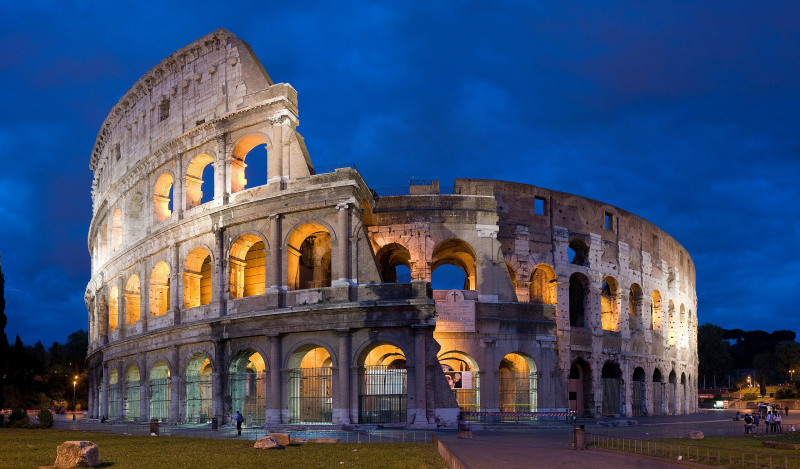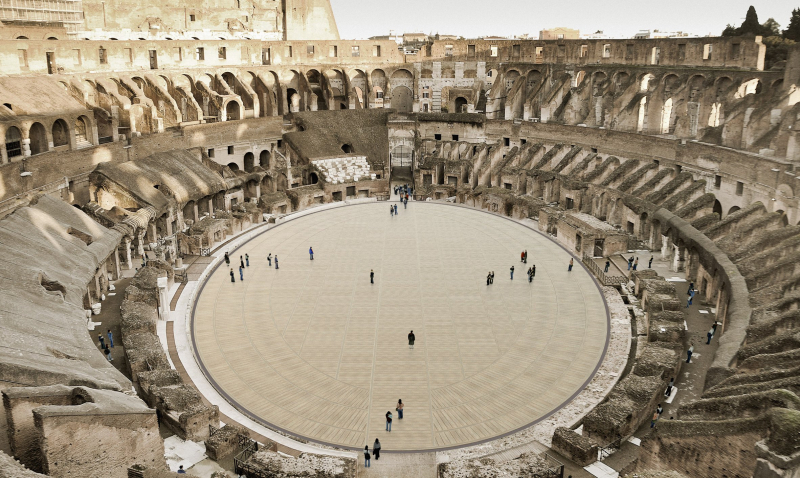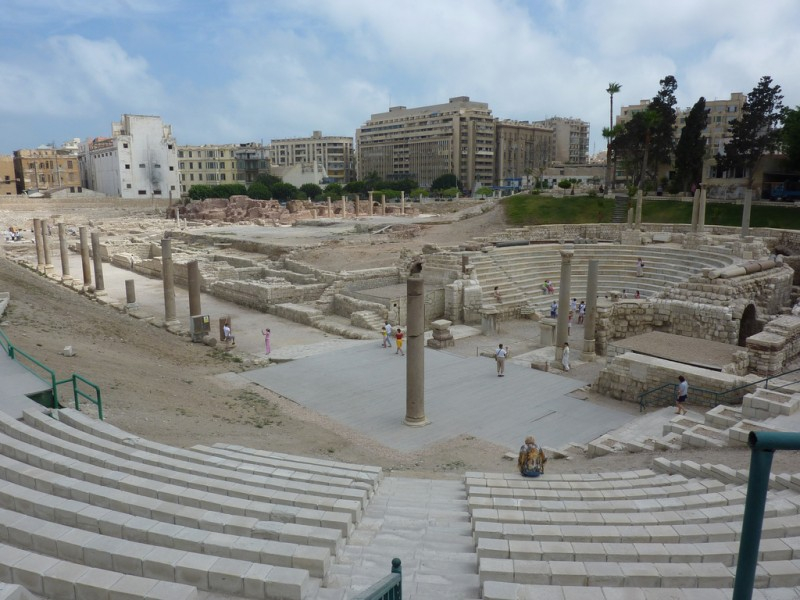Top 9 Best Roman Amphitheatres To Visit in The World
Amphitheaters had an important role in ancient Roman society. Along with the development of people, their architecture is also more and more perfect. Joining ... read more...with Topist to find out the best Roman amphitheatres to visit in the world!
-
The first position on the list of the best Roman amphitheatres to visit in the world is the Colosseum. When the Roman Empire was at its height, the Colosseum, or "Colosseo" in Italian, was its biggest amphitheater. Emperor Vespasian constructed it in the first century AD as a recreational area for the inhabitants of Rome. Vespasian, who saved the Roman Empire from extinction, would not survive to see the Flavian Amphitheatre's completion, despite it being originally called after his family name.
A trip to the Colosseum provides a fascinating insight into the life of Roman residents and those unfortunate enough to fight there. For many, the Colosseum is a symbol of the might, showmanship, and brutality of ancient Rome. Particularly, one can now take a tour of the underground passageways and rooms where the gladiators of ancient Rome would practice their fights and reflect on their mortality. The top parts of the building, from which you can see the Roman Forum, have also just been opened.
The Colosseum has a museum with a lot of intriguing artifacts and information, and there are audio guides in a number of different languages. Around 7 million people visit the Colosseum each year, so it's wise to purchase your tickets online and go earlier or later in the day to avoid the busiest times. Only by guided tour, which must be scheduled in advance, are the Terrazzo Belvedere's top three levels and the hypogeum accessible. The main building is also open for guided visits. Unsurprisingly, security is strong.
Location: Piazza del Colosseo, 1, 00184 Roma RM, Italy
Photo: wikipedia 
Photo: hoctiengy.com -
In the present-day Tunisian city of El Jem Amphitheatre , originally Thysdrus in the Roman province of Africa, there is an oval amphitheater called the Amphitheatre of El Jem. Since 1979, UNESCO has included it on its list of World Heritage Sites.
The amphitheater was constructed in Thysdrus, which is now El Jem, Tunisia, and was part of the Roman province of Africa Proconsularis, in the year 238 AD. It is exceptional in Africa and one of the best-preserved Roman stone ruins on the entire globe. It is one of the largest amphitheatre in the world and was constructed for spectator events, like other amphitheatres in the Roman Empire. The big and small axes are respectively 148 meters (486 feet) and 122 meters in length, and the anticipated capacity is 35,000. The amphitheatre is made of stone blocks, situated on level ground, and has been preserved unusually well.
Today, you descend a set of steps that resemble stadium seats to get to El Jem Amphitheatre. Explore every crevice of the historic stadium within, from the arena where gladiators would have been waiting to fight them to the underground corridors where animals were prepared for games. For a more thorough overview of the theater's history, you may also sign up for a guided tour. Otherwise, take your time exploring the area before visiting the small store to buy a souvenir.
The Colosseum in Rome, which is older and larger but not much so than the El Jem Amphitheatre, looks a lot like it from the exterior. Many contend that the El Jem Amphitheatre is actually in greater shape than the Colosseum due to its numerous original features, like its tiered seats, arches, and elliptical stone walls, some of which are intact up to 35 meters in length.
Location: musée, El Jem 5160, Tunisia
Photo: attenvo.com 
Photo: wikipedia -
One of the best Roman amphitheatres to visit in the world is Nimes Arena. In the French city of Nîmes, there is a Roman amphitheater called the Arena. It is one of the best-preserved Roman amphitheatres in the world and was constructed around 70 CE, not long after the Colosseum of Rome. [Reference needed] Its dimensions are 133 meters (145 yards) long, 101 meters (110 yards) wide, and 68 meters (74 yards) by 38 meters for the arena (32 yards). The exterior facade has two floors and 60 arcades that are 21 meters (69 ft) high. Of the 400 Roman amphitheaters still standing, it is among the 20 largest. The structure could accommodate 24,000 spectators in Roman times, who were dispersed over 34 stories of terraces that were divided into four separate areas, or maeniana. The Romans constructed the arena as both a gladiator arena and a venue for public events.
The Nimes Arena has been completely restored and is now a well-liked tourist destination that offers visitors a look into the dramatic world of the Roman amphitheatre. The website is not only amazing but also quite educational and ideal for fans of ancient history because it includes an interactive audio commentary and in-depth exhibitions.
In addition to its historical significance, Nimes Arena is still utilized for events today, such as the 'Great Roman Games' and two bullfights that take place twice a year during the Feria de Nimes.
Location: France, Nîmes
Photo: vn.trip.com 
Photo: wikipedia -
The Arles Amphitheatre, also known as the "Amphithéâtre d'Arles," is a sizable sports stadium constructed by the Romans sometime in the first century BC or AD, during the reign of Augustus (27 BC-14 AD). Arles benefited from the construction of various monuments, the Arles Amphitheatre being one of the largest at the time. At the time, Arles was thriving as a Roman colony.
Arles, also referred to as the "Soul of Provence," is a city in the Bouches-du-Rhône department of the Provence-Alpes-Côte d'Azur region of southern France. The Arles Amphitheatre, which has more than a hundred Corinthian and Doric columns arranged over two floors and is 136 meters long, was constructed to hold more than 20,000 spectators.
Arles Amphitheatre is still in use today, however, bullfights are held there instead of chariot racing due to its remarkable condition preservation. This occurs most prominently at the well-known festival Feria d'Arles, which has two events: one in April and one in September.
Today, guests can stroll through the amphitheatre or, with a little more forethought, attend a live performance there. Visitors should also try to see some of the other Roman sites in Arles, such as the Archaeological Museum, the Constantine Baths, and the Arles Roman Theatre.
Location: 1 Rdpt des Arènes, 13200 Arles, France

Photo: historyhit.com 
Photo: beyond.fr -
The next position on the list of the best Roman amphitheatres to visit in the world is the Pula Arena. In Pula, Croatia, there is a striking old Roman amphitheatre called Pula Arena, also called Pula Amphitheatre. The Pula Arena was built in the first century AD, under the rule of Vespasian, who was also the founder of the Colosseum. With a capacity of about 20,000 spectators, Pula Arena would have hosted knightly tournaments throughout the Middle Ages as well as gladiatorial fights during the Roman era. The amphitheatre is now such a significant landmark that it is featured on Croatia's 10 kuna banknote.
The Pula Arena is the only structure of its sort still in existence with all 4 side towers intact. The shows at Pula Arena are far more subdued than those of its earlier incarnations. It has a capacity of over 7,000 people, both standing and seated.
Stop by a theatre, a film festival, or a concert. Previous performers have included Leonard Cohen, the Foo Fighters, and Elton John. On-site ice hockey matches have also been played a number of times. Or simply explore this amazing, old place and picture the vibrant social hub that it was 2,000 years ago.Location: Flavijevska ul., 52100, Pula, Croatia

Photo: wikipedia 
Photo: viator.com -
After the Colosseum and the Campania Amphitheatre, which served ancient Capua, Verona Arena (Arena di Verona) is a magnificent Roman amphitheatre that was constructed in the first century AD.
The arena suffered after the decline and fall of the Empire, as did many other similar Roman structures, and it was pillaged for masonry during the Middle Ages. Despite this, Verona Arena still stands in outstanding condition today and continues to hold a variety of events, operas, and outdoor shows after some repair.
The first and least-remaining of the three elliptical rings of arches that formed up the Verona Arena, which was constructed outside the city walls in 30 AD, are the second and third rings. A variety of ancient entertainment, including the renowned gladiatorial games, would have been held in the arena, which in its heyday could accommodate up to 30,000 spectators.
One of the best-preserved ancient structures of its sort, the Verona Arena is now known throughout the world for its breathtaking opera performances. The Verona Arena is open from 8:00 a.m. to 6:00 p.m. and has 44 levels of seats that can accommodate 22,000 people. Visitors can ascend to the highest level during the day to see the entire stadium and the surrounding area. The Verona Arena is magnificently illuminated at night, showing the finest in Roman construction.
Location: Verona, Italy

Photo: wikipedia 
Photo: wikipedia -
At the mouth of the Wadi Lebda on the Mediterranean, Leptis or Lepcis Magna, also known by various names in antiquity, was a significant city of the Carthaginian Empire and Roman Libya. Leptis Magna is one of the best Roman amphitheatres to visit in the world.
The Roman Emperor Septimius Severus (193-211), who was born in the city, considerably enlarged the Phoenician foundation that had been there since the 7th century BC. To protect the city from Berber raids, the 3rd Augustan Legion was stationed here. The city became more vulnerable to invasions in the latter third of the third century with the collapse of the legion under Gordian III in 238. The city was made the provincial capital once again by Diocletian, and it enjoyed newfound prosperity until it was conquered by the Vandals in 439. Although it was once again a part of the Eastern Empire in 533, Berber incursions continued to haunt it, and it never regained its former prominence. In the wake of the Muslim invasion in around 647, it was abandoned.
Despite the several invasions that Leptis Magna experienced beginning in the fourth century and ending with the Hilalians in the eleventh, these sites can still be seen there today. Leptis Magna is now recognized as a UNESCO World Heritage site.
Location: Khoms, Libya
Photo: m.sworld.co.uk 
Photo: vivi.org -
The remains of the Roman Amphitheatre of Carthage, a significant Roman stadium, can be discovered close to Tunis, Tunisia, in contemporary times. Carthage's amphitheatre is thought to have been constructed around the end of the first century AD and could accommodate up to 35,000 spectators.
The amphitheatre in Carthage, which was established in the first century BC, was restored by the tyrant Julius Caesar when the city was made the center of the Roman province of Africa Proconsularis. The amphitheatre, according to an Andalusian historian named Al-Bakri who lived in the 11th century, is made up of circular arches supported by columns and decorated with "images of animals [...] figures that symbolize the winds: the East seems cheerful, and the West has a frowning countenance."
There isn't much of the amphitheatre left today, despite some evidence that it was still standing in the early middle ages. Despite winning the admiration of travelers, the materials for the amphitheatre were routinely stolen for use in other construction projects.
The Roman Amphitheatre of Carthage has mostly been destroyed by ruins, unlike other Roman amphitheaters in North Africa like El Jem. Thought to be able to accommodate at least twice as many spectators, a Roman circus close by has been all but lost to history and offers next to nothing in the way of sights.
Location: Tunis, Tunisia

Photo: historyhit.com 
Photo: dreamstime.com -
The only one of its kind in the nation, the Roman amphitheatre in Alexandria, Egypt, is a sizable circular Roman theatre. Although it is frequently mistaken for an amphitheatre, the location is more like a small Roman theatre than a vast sporting venue. Alexander the Great's tomb was originally the target of the site's excavations, but an Ancient Roman theatre from the fourth century instead was found.
The discovered ruins featured genuine Roman marble chairs, several courtyard mosaics, and even graffiti depicting the rivalry between local chariot team followers. Along with the theatre itself, the location also includes the ruins of a bathhouse complex, as well as a number of additional rooms and habitations.
Visitors can experience Alexandria's Roman Amphitheatre right now. Along with the more basic pleb galleries and 13 auditoria that might have been a part of the ancient university, the original marble benches, which could accommodate 700 people, can be seen.
The vast complex's floors are still covered in numerous columns and exquisite Roman mosaics, and visitors may also explore the nearby ruins of a Roman bathhouse and a villa known as the "Villa of the Birds" because of its exquisite mosaic artwork.Location: Ismail Mahana Road أمام محطة مصرالسكة الحديدية، Kom Ad Dakah Gharb, Al Attarin, Alexandria Governorate 21517, Egypt

Photo: traveltoegypt.net 
Photo: memphistours.co.uk






























